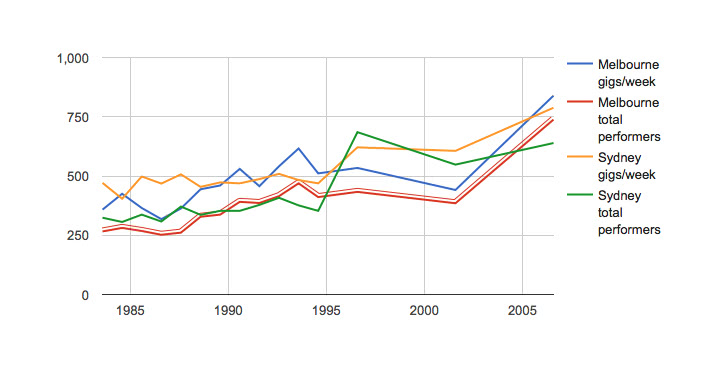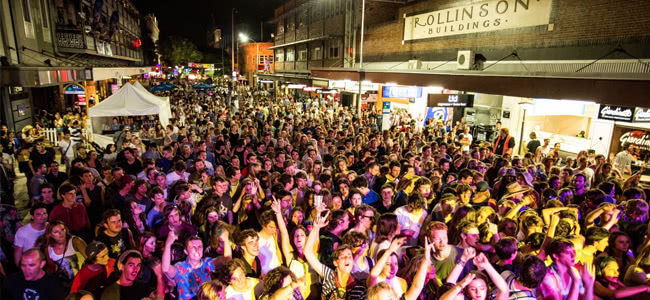Sometimes it feels like we’re in the grips of a perpetual live music crisis. There’s not enough venues, not enough bands, not enough paid gigs, and it’s all just come about in the last couple of years.
But according to Sarah Taylor, a musician and researcher from RMIT currently completing her PhD, the history of Sydney and Melbourne’s music scenes isn’t quite the linear downward trajectory we tend to think it is.
As ABC News reports, Taylor is mapping data sourced from local gig guides over a 23-year period from 1983 and comparing it with census data from the Australian Bureau of Statistics to illustrate how live music has changed in that time.
So what’s the biggest change since 1983? Well, for starters, the number of bands in each city has increased as the number of performances they actually put on has decreased. And it’s a different story altogether for venues.
To get an idea of the changes that have occurred you first have to understand the live music scene in Melbourne and Sydney in the 1980s, which comprised of a small community of bands gigging several times a night in suburban venues.
According to Taylor, there was “a lot more money sloshing around” and a “clear route to success” that basically went: get on Countdown, play two or three times a night, and watch the money roll in.
“It would be quite common [for booking agents] to say ‘you’re playing Fern Tree Gully then you’ll go across town and you’ll play in Geelong the same night’,” Taylor told ABC News.


Images via ABC News
“They would play three sets and some of them would be originals, but most of them would be covers.” A well-known band stood to earn several thousand dollars for one show with smaller bands nabbing about $300.
Things began to change in the late ’80s with the end of Countdown, which meant bands were now less likely to become household names overnight. However, the show’s role was soon taken over by the likes of triple j and the Big Day Out.
“I keep honing in on the late eighties as when times change and when things started to get more familiar to what I see in music nowadays,” said Taylor. “Countdown was this thing that everyone understood, if you got through Molly then everything was OK.”
“There’s definite reports, especially in Sydney of things dying, drying up. It was like, ‘oh my goodness, there’s not many venues’. That worry subsides because more exciting things came along early in the 90s.”
“Certainly by the time you have Silverchair come along the excitement that you might win a competition… was enough to quell that worry about what was happening with the live scene.”
Meanwhile, the number of gigs was increasing as the number of venues both declined and changed geographically. “My purpose from the outset was to map [the gigs] and then figure out what was causing their decline,” Taylor said.
[include_post id=”435607″]
“During the course of the research I kept going ‘when is it going to happen, when is it going to happen’ and it never did.” That perception, Taylor said, came about because bands were playing less often and the route to success was less clearcut.
It’s around this time also that the live music scene we’re more familiar with today began to form and the Sydney scene began to diverge from the Melbourne scene, partly due to the city’s prohibitive liquor licensing.
As we entered the 2000s, the internet became another route of exposure for young artists, but concerns about a vibrant live music scene continued. In particular, it became harder than ever to find paid gigs in Sydney.
“In the interviews I’ve done a few people have referred to [2006] as ‘my internet year’,” said Taylor. “You could sell your music anywhere but what people are most worried about more than ever is ‘Where can I play here?'” Follow Ms Taylor’s research over on her blog here.

































